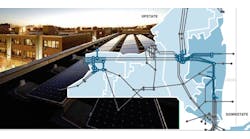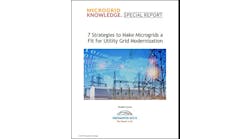Consolidated Edison wants to test out a new energy storage business model in a project planned with microgrid developer GI Energy at four customer sites.
The New York utility proposed the demonstration project in a Reforming the Energy Vision (REV) filing before the state Public Service Commission late last week (Case 14-M-0101).
The new model pays customers for hosting batteries through leases. It is designed to spare customers the confusion of navigating complex wholesale markets to make money from a battery.
Instead, customers simply engage in a “real estate transaction that does not require an understanding of utility rates or tariffs,” Con Edison said in the filing. The proposition becomes about space rather than demand charges.
Con Edison hopes the new energy storage business model will avert roadblocks to battery use and eliminate skewed incentives for developers. The current market encourages developers to cherry pick the small number of customers with peaky load profiles, since they can derive more revenue than those with flatter load profiles.
The utility looked at two hypothetical customers, one with a peaky load, one with a flatter, longer load. The first could yield $568,800/year through use of a 2MW/1 MWh battery that nets a 2 MW demand charge reduction over 30 minutes. The second achieves only a 200-kW demand charge reduction, yielding $56,900/year.
This problem not only limits who gets storage, but also encourages developers to engage in a “scavenger hunt for the perfect load profile,” said Con Edison. Developers are encouraged to “shoehorn battery projects into locations that may not be ideal.”
Simplified for customers
Very few customers understand the finer points of energy tariffs, making it difficult for them to derive full value from behind-the-meter energy storage, according to the utility. That’s why Con Edison proposes locating the storage in front of the meter. This disconnects project economics from the customer’s electricity usage, the utility said.
Instead of deriving value via demand charges and ICAP tag reductions, the customer receives a lease payment for housing the batteries. Con Edison said this simplifies the value proposition from a complicated demand charge reduction calculation to $/square feet revenues.
The energy storage business model involves three main parties that split the value: the utility, a developer (in this case microgrid developer GI Energy) and the host customer.
Here’s how it works.
GI Energy obtains third-party financing to cover initial project costs. Con Edison pays the developer a quarterly fee to cover customer lease payments, operations and maintenance services, operation and dispatch of assets, financer’s return on investment, balance of system, and integration.
Con Edison receives benefits via wholesale market revenues realized from dispatch of the battery (GI Energy also receives a smaller portion of the wholesale revenue.) The utility will also benefit by treating the project as a non-wires alternative, a way for Con Edison to defer more costly infrastructure upgrades.
The utility has primary dispatch rights and lets GI Energy know when it needs the batteries for the benefit of the grid. Other times, GI Energy dispatches the batteries into the wholesale markets to tap into various revenue streams, such as energy arbitrage, capacity, and frequency regulation.
Meanwhile, the host customer receives a flat quarterly, lease payment for housing the battery.
Less utility involvement eventually
Con Edison sees the model eventually evolving into storage as a service, where the utility pays only for the portion of assets needed to derive grid benefits and the right of first dispatch.
However, for purposes of the demonstration project, the utility takes a larger financial role to attract wary investors to the nascent market. Because the utility underwrites more of the project, it receives a larger share of the wholesale revenue.
Con Edison expects the demonstration to result in new rules that can increase market certainty for investors.
To test the concept, Con Edison and GI Energy plan to install a 1.1 MW/1 MWh batteries at each of four sites, likely for large commercial, industrial, or institutional customers.
The project would use NEC lithium batteries. One site also would include an Urban Electric Power 200 kW/400 kWh zinc manganese dioxide battery system, a non-flammable chemistry used to avoid concerns about battery fires that can create permitting issues for indoor installations.
The project will use controller technology by Smarter Grid Solutions, a Brooklyn company that has been working with Con Edison on a separate microgrid project co-funded by the New York State Energy Research and Development Authority.
Con Edison hopes to install the batteries between May and December this year, test dispatch next year, and enter the project into the wholesale market in 2019.
Track news about Con Edison’s energy storage business model by subscribing to the Microgrid Knowledge newsletter. It’s free.
[clickToTweet tweet=”Con Edison proposes new #energystorage business model. ” quote=”Con Edison proposes new energy storage business model. “]







